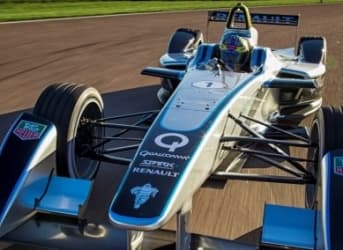Jeremy Clarkson may have something to say about it, but the testosterone and fossil-fueled sport of Formula 1 is apparently going green. The former Top Gear presenter would undoubtedly defend a sport in which 8,000 liters of fuel is burnt in a weekend, but as it turns out, Clarkson and other F1ers are dinosaurs: Formula 1 now has competition from Formula E, where, you guessed it, E is for electric.
It doesn't take a marketing genius to assume that, to a generation brought up with Al Gore's Inconvenient Truth, 20-odd combustion-engine cars whizzing around a track sucking gas at 375 km/h (233 mph) might appear, well, unseemly. Now there is actually an alternative. Today's EV technology has reached a point where electric cars are more than just fancy rides for planet-saving celebrities or those who can afford a Tesla.
While F1 cars have effectively been hybrids since 2009, in 2014 new rules were put in place that cut the amount of fuel used by a third, prompting changes in design. Last year the first Formula E championship kicked off in Beijing, the first of 10 cities to host races featuring high-performance EVs. Related: This Innovation Will Help U.S. Companies Win The Oil Price War
The teams, backed by “green” celebrities like Leonardo DiCaprio and Richard Branson, race Spark-Renault SRT_01E Formula E cars using technology from F1 teams McLaren and Williams. Unlike regular Formula 1, the cars do not refuel in pitstops; rather, the drivers swap vehicles due to current EV battery limitations. The cars all have an identical chassis and drivetrain, as well as a huge lithium-ion battery that makes up a third of the car's weight. The familiar roar of F1 engines is replaced by a high-pitched whistling sound, “a bit like a dentist's drill” described one journalist, covering the first Formula E race in the United States this past March in Miami.
Formula E cars reach a maximum speed of 150 mph, and drivers change vehicles half-way through when the battery in the first car starts to run out. Related: Does Fossil Fuel Divestment Make Sense?
The greening of motorsport isn't just confined to electric vehicles, either. In 2008 the world's first zero-emissions motorcycle race took place on the Isle of Man, UK, featuring electric bikes. A few years earlier, Dutch entrepreneurs built the world's first fuel-cell-powered go-kart, then raced it in the 2008 Formula Zero Championship, a race series consisting of six universities that competed on a 2-mile mobile race track.
Meanwhile NASCAR, yet another symbol of the combustion engine at the apex of its power, has made strides in making the sport more politically palatable. According to NASCAR Green, the sport has cut its carbon emissions by 20 percent through the use of biofuels, and a “significant number” of NASCAR tracks rely on solar power as an energy source. These include the 3MW solar farm at Pocono Raceway and a 9MW solar facility at Indianapolis Motor Speedway. Related: Toyota’s Unique Investment Plan To Dominate The Green Car Sector
Technologies developed for Formula E are also finding their way into mainstream applications, possibly even a supermarket near you. Williams F1, the British Formula 1 motor racing team and constructor, in April “unveiled plans to fit aerofoils developed from racing cars to supermarket fridges so as to save energy, while a fuel-saving F1 flywheel is being tried out in buses. It is even supplying ecologically- correct supercars for the next Bond film,” reported The Telegraph.
The aerofoils redirect the flow of air to stop cold air from escaping from supermarket refrigerators into the aisles. Sainsbury's, the UK supermarket chain, has used the aerofoils to cut energy use by 30 percent, according to the Telegraph.
Whether Formula E garners the same global following as Formula 1 remains to be seen, but it is clear that the greening of motorsport is aimed at a new demographic where “green is sexy” and new, sustainable technologies are the way of the future. As Alain Prost of e.dams Renault put it, “F1 is for people over 40.”
By Andrew Topf of Oilprice.com
More Top Reads From Oilprice.com:
- Does Nuclear Power Deserve Such A Bad Image?
- A Spanner In The Works Of The Solar Revolution
- 5 Solar Stocks That Should Be On Your Radar


















